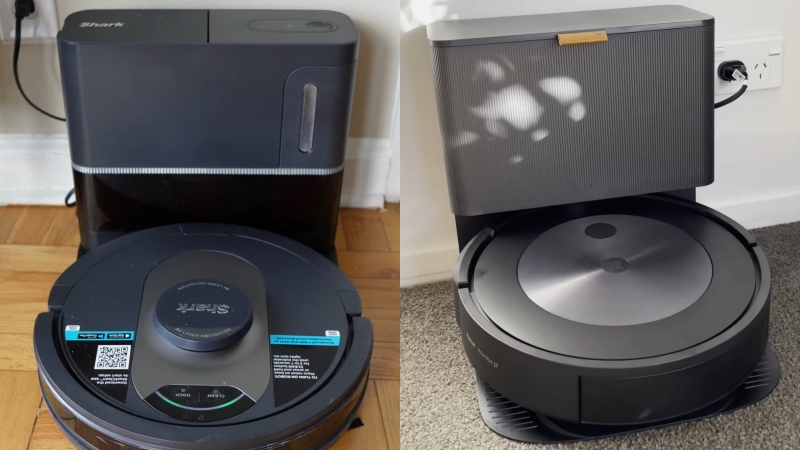In the realm of automated home cleaning, the Shark AI Ultra vs Roomba J7+ are two frontrunners, each vying for the title of the ultimate robotic vacuum. For me, the Roomba J7+ emerges as the undisputed champion.
With its Imprint Smart Mapping technology, the winner Roomba J7+ allows you to save multiple maps while offering good navigation, ensuring comprehensive coverage of your home. Its PrecisonVison technology is impressively effective, helping the bot avoid things like cords and pet waste. The Shark AI Ultra is a formidable competitor with the LIDAR navigation. The LIDAR gives efficient navigation and home mapping without getting the robot bumped into walls and furniture but fails to avoid obstacles shorter than 4 inches.
For those tired of emptying dustbins, the Roomba J7+ comes with an innovative self-emptying feature, while the Shark AI Ultra offers a similar option. Both robots are equipped with obstacle detection and edge-cleaning capabilities. Whether you prioritize mapping precision, allergen control, or hands-free maintenance, this showdown between Shark AI Ultra vs Roomba J7+ promises a cleaner, smarter home tailored to your needs.
Shark Ai Ultra Vs Roomba J7+: Comparison Chart




Shark Ai Ultra Vs Roomba J7+: Differences
In the showdown between Shark AI Ultra vs Roomba J7+, the iRobot Roomba J7+ wins 3-0 against its rival. Its performance and design are quite better than those of the Shark AI Ultra. Read on for details!
Cleaning performance
Winner: iRobot Roomba J7+
Suction
The Shark AI Ultra possesses a superior suction power to the Roomba J7+, which is also higher than the average suction for most of robot vacuums in the market. The collected airflow and suction of the Shark AI Ultra and Roomba J7+ are in the table below. Interestingly, the higher suction power does not mean better cleaning performance, which I will discuss later.
| Shark AI Ultra | iRobot Roomba J7+ | |
|---|---|---|
| Airflow (cfm) | ~18 | ~ 7 |
| Suction (kPa) | 0.8 | 0.07 |
Carpet and hard floor
When cleaning on a hard floor, both perform quite the same results, decently collecting small to medium-sized and light to solid heavy debris particles like oats, sand, cat litter, and pet hairs. Yet, they still have some struggles when collecting bundles of short pet hairs, often pushing them to the edge or corners of the room. Overall, their hard-floor cleaning performances are quite satisfying to me.
Though the Roomba J7+ has inferior suction power to the Shark AI Ultra, its carpet cleaning performance is relatively better, especially in deep cleaning tests. The carpet cleaning efficiency of the Roomba J7+ can score up to 90%. Meanwhile, that of the Shark AI is about 80%, which is also an impressive number.
However, the Shark AI Ultra seems to be easily choked up when vacuuming debris particles having a similar size to a small rock. The leaves of similar size also get caught easily in the Shark AI robot’s spinning rolls, making a louder noise, especially when it is on the hard floor. Yet, I have not encountered such problems with the Roomba J7+ so far.
Edge cleaning
Though the brand claimed that Shark AI Ultra features CleanEdge technology to improve edge cleaning efficiency, its performance is not as impressive as the Roomba J7+. In my tests, the Shark AI Ultra cannot pick up all the debris on the edges, while the Roomba J7+ performs pretty well in such tests. This could be attributed to the side brush designs of each machine.
The Shark AI Ultra comes with two side brushes, but each brush features a single bristle prong. Meanwhile, the Roomba J7+ has one side brush with 3 prongs of bristles. With a greater number of brush strings, the Roomba J7+ has a higher contact frequency with the edge, improving the edge-cleaning result. Moreover, the side brushes of the Shark AI Ultra seem too short to get the edges well, making its performance inferior to the Roomba J7+.
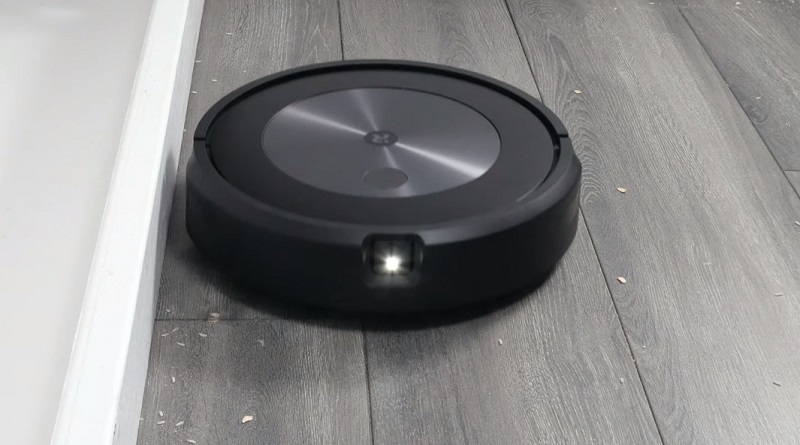
Pet hair
These two robot vacs can handle pet hair and human hair well, both with long and short hair strands. They can clean all the pet hair tufts on the floor in two or three passes. However, the Shark AI Ultra is inferior in hair resistance tests. The Roomba with all rubber brush rolls excels in reducing the hair tangling amount with an efficiency of up to nearly 90%.
In fact, both of them are not 100% effective in preventing hair wrap. When I run tests with longer hair strands, the amount of hair staying on their rollers is quite noticeable but still below average. So, make sure to check the rollers after cleaning to remove all hair strands left on the brushroll so that the robot vacuums can function well.
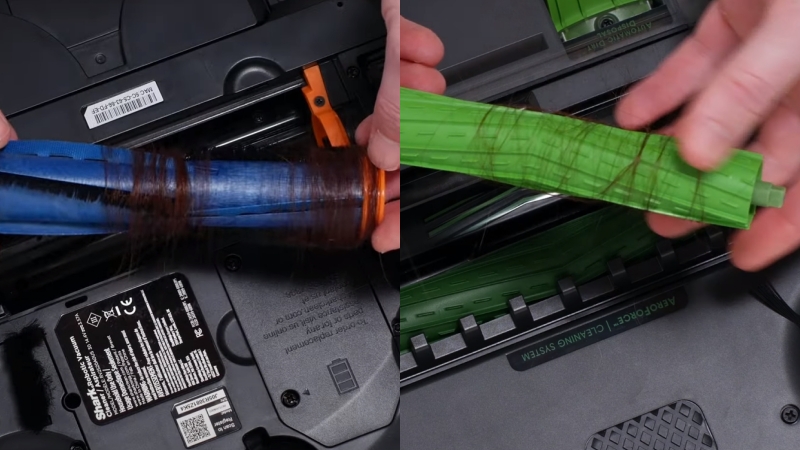
Design & Convenience
Winner: iRobot Roomba J7+
Brush roll systems
The Roomba J7+ uses the dual-brushroll system instead of the single brushroll like the one on the Shark AI Ultra. Moreover, iRobot J7+ features a wider cleaning path with a main brushroll width of about 6.75 inches, while that of the Shark AI Ultra is approx. 5.75 inches. With the greater brushroll width and the second brush roller, the Roomba J7+ offers greater surface agitation, which contributes to enhancing the overall cleaning performance.
Additionally, the patented rubber rollers of the Roomba J7+ significantly support the hair-tangling resistance. The Shark AI Ultra is also decent in hair-tangling resistance owing to its self-cleaning brush roll, but is not as efficient as the Roomba J7+. It is because the brushroll of the Shark AI still has stiff bristles, making it easier to catch hair on the roller.
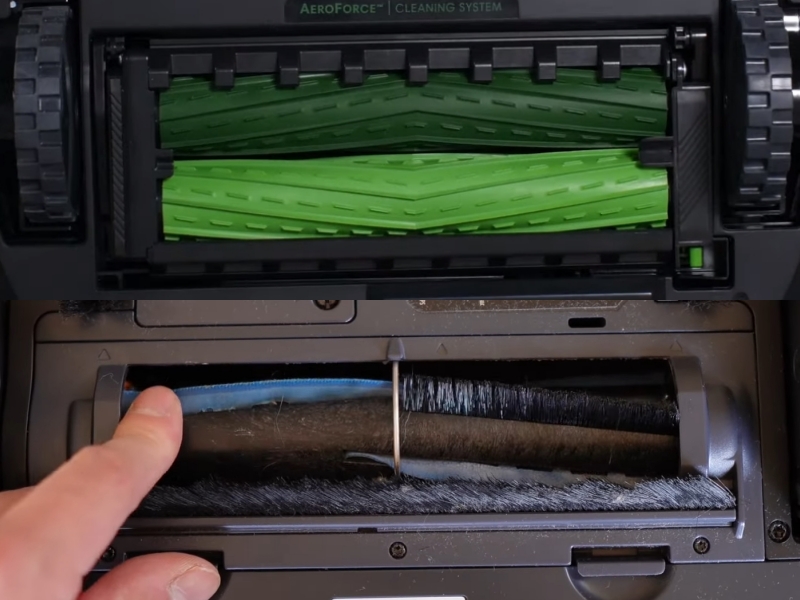
Navigation & Obstacle avoidance
- Navigation & Mapping
The Shark AI Ultra uses the LIDAR sensor, while the iRobot J7+ features a front camera to map the cleaning spaces and navigate the vacuums. After testing, I’m more impressed by the LIDAR navigation of the Shark AI.
The LIDAR allows the Shark AI to map my room quickly and easily without bumping into walls or furniture. The Shark moves around the objects in my room amazingly and effortlessly. It still bumps into things with “odd” shapes that the LIDAR cannot detect, for example, the table legs with curvy lines. Well, its bumper is also good, as after a slight bump, the robot can know how to navigate around.
The front camera of the iRobot J7+ also does a good job of home mapping and navigating. In fact, the iRobot J7+ relies much on the bumper to learn the floorplan, thus, it often bumps into things and walls to complete the map. Hearing the Roomba J7+ constantly bumping into walls is somehow frustrating.
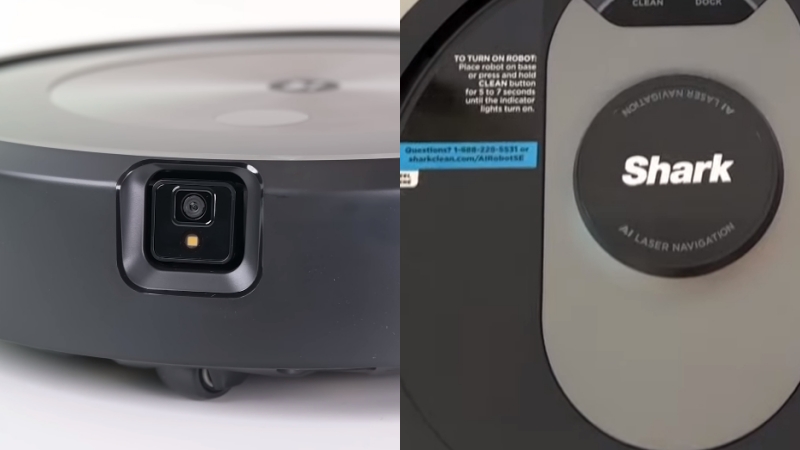
Besides, both Roomba J7+ and Shark AI perform well in escaping from small places such as between chairs or legs. Since I used them, I never found them get stuck and need my support to escape. Moreover, they feature cliff sensors for detecting stairs and preventing them from falling down.
Additionally, the Shark AI Ultra and iRobot Roomba J7+ offer nice cleaning coverage with multi-pass cleaning. They fully clean the mapped floor most of the time. They also automatically find their ways to return to the bases to empty their dirt bins or charge and then back to the spots they leave off to finish the cleaning.
- Obstacle avoidance
However, when it comes to avoiding objects on floors, the Shark AI Ultra is inferior to the Roomba J7+. The LIDAR sensors do not effectively recognize things too low to the sensor level. The brand also notes that the LIDAR works with objects taller than 4 inches. Moreover, occasionally, the Shark AI Ultra’s bumper or lidar sensors cannot detect light furniture like water glasses and light plant stands, so it often bumps into things and causes a mess. It also fails the test of avoiding pet waste.
On the other hand, the Roomba J7+ does well in obstacle avoidance owing to the PrecisonVison Navigation technology. The Roomba J7+ realizes and avoids the heavy and light obstacles on the floor like cords, socks, shoes, and even pet waste effectively – the Shark AI cannot avoid such objects.
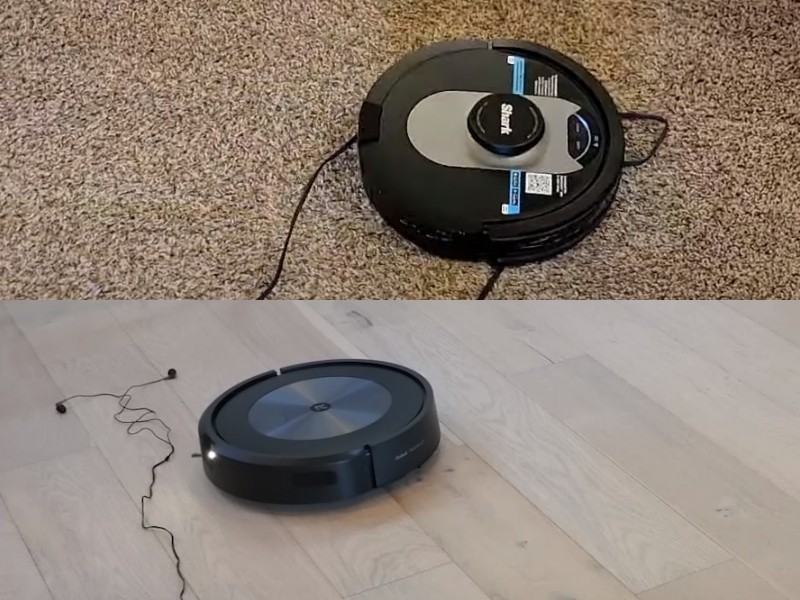
Battery life
Battery life is what I want to complain about these vacuums. Specifically, the Roomba J7+ runs for about 60 minutes and returns to the base for recharging. The runtime of the Shark AI Ultra is even worse, working for about half an hour and needing to recharge. The Shark AI Ultra also takes a longer time to fully charge and resume the cleaning than the Roomba J7+.
| Shark AI Ultra | iRobot Roomba J7+ | |
|---|---|---|
| Battery life | ~30 minutes | ~60 minutes |
| Charging time | ~3 hours | ~2 hours |
Noise levels
I found that they were all noisy when their bases operated the dirt disposal. When these bots were vacuuming, I found the noise levels were reasonable. However, the Shark AI Ultra is a bit louder than the iRobot Roomba J7+ while operating. Their noise levels vary depending on the cleaning surfaces. I measured and summarized the data in the following table; you can take it for reference.
| Shark AI Ultra | iRobot Roomba J7+ | |
|---|---|---|
| Vacuuming | ~51-68 dB | ~50- 60 dB |
| Self-emtyping | ~80 dB | ~78 dB |
Control
Winner: iRobot Roomba J7+
Physical control
As they are mostly controlled by apps on your smartphones or tablets, their physical controls are simple. The Shark AI Ultra has two buttons, CLEAN and DOCK, on its body for starting or stopping the cleaning task and returning to the base, respectively. The Roomba J7+ has only one physical button to control the mentioned functions.
Remote app control
Smart app control is crucial for robot vacuums. I have had a better experience using the app of the Roomba J7+ than of the Shark AI Ultra. Generally, both of them allow me to label the room, set no-go zones, and schedule the cleaning. Additionally, I can use voice commands to control them, as they are compatible with Alexa and Google Assistant.
However, the Roomba J7+ supports saving up to 10 maps, enabling the convenience of cleaning different floor levels without deleting the old floor plan. Meanwhile, the Shark AI only saves one map, and I need to delete the old map and let the bot remap the new floor, which lengthens the cleaning time.
Besides, the Shark AI Ultra sometimes ignores the no-go zone and persistently cleans these areas, even though I set and save the settings. With the Roomba J7+, I haven’t encountered such issues, and the app has been working great so far.
Cleaning & Maintenance
Tie!
The cleaning and maintenance for these two robot vacuum products are similar. Though they are decent at reducing the hair-wrap issue, longer hair still gets caught on their roller, so make sure to check and clean the brushroll after the robot finishes vacuuming.
In addition, they all feature the self-emptying function, allowing them to return to the cleaning base when their dirt bins are full and resume cleaning after the self-emptying is done. This means I don’t have to dump the robot’s dirt bin every day.
However, the difference between them is in the self-cleaning base’s dirt container. The Roomba J7+ goes with a bagged clean base like others in the market. Meanwhile, the Shark AI Ultra decided to go differently with a bagless dirt container. Moreover, the filters and the dirt bin of the Shark AI’s clean base can be washed with cold water.
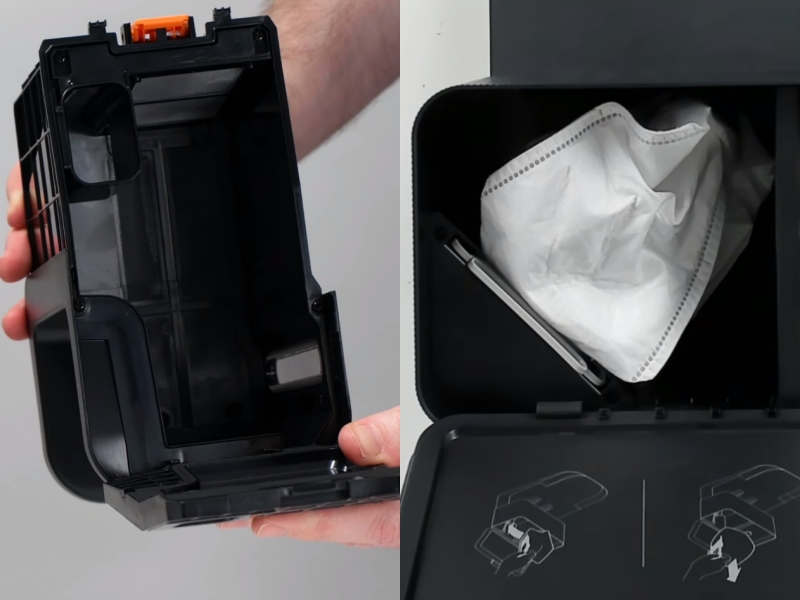
In terms of being sanitary, using the bagged type is definitely a better choice because there is no hassle of dust clouds when emptying the dust container of the clean base. The downside of this type is the recurring cost of purchasing extra dust bags. Conversely, the bagless type will reduce the need to buy dust bags, saving costs, but I have to face the dust clouds when emptying the bin. So, if hygiene is more important to you, the Roomba J7+ is the better option.
Besides, for the clean base capacity, iRobot claims that the Roomba J7+ dust bag can hold up to 60 days without replacement. Meanwhile, the Shark AI Ultra’s clean base capacity varies from 30 days to 60 days, depending on the model numbers. For instance, the Shark AV2501S has a 30-day capacity, while the Shark RV2502AE has a 60-day capacity.
Quick Rundown of iRobot Roomba J7+
- CLEANS WHEN AND WHERE YOU WANT– Only iRobot brings you Imprint Smart Mapping allowing you to control and schedule which rooms are cleaned and when, while storing multiple maps for easier cleaning on each level of your home.
- AVOIDS PET ACCIDENTS – WE GUARANTEE IT - IRobot brings you P.O.O.P. (Pet Owner Official Promise). You can rely on your Roomba j7+ to avoid pet waste, or we’ll replace it for free. Additional terms and conditions apply – see iRobot website for details.
- IT DOESN’T JUST LEARN YOUR HOME; IT REACTS TO IT IN REAL TIME. With PrecisionVision Navigation and a camera, your robot identifies and avoids obstacles of all sizes like pet waste, charging cords, socks and shoes to get the whole job done.
- MORE THOUGHTFUL THAN YOU THOUGHT - The Roomba j7+ takes vacuuming off your mind with personalized cleaning suggestions powered by the unique intelligence of IRobot OS. Learns your habits and your routines.
- POWERFUL PERFORMANCE. The 3-Stage Cleaning System packs 10x the Power-Lifting Suction, an Edge-Sweeping Brush gets along walls and corners, and Dual Multi-Surface Rubber Brushes flex to adjust to different floor types. Compared to the Roomba 600 series.
Quick Rundown of Shark AI Ultra
- INCREDIBLE SUCTION: Powerful Shark suction picks up dirt and debris on all floor types—tackling even the toughest of messes in your home.
- NO SPOTS MISSED: With Matrix Clean Navigation, the vacuum cleans in a precise matrix grid taking multiple passes over dirt and debris for whole home, deep cleaning coverage.
- IT EMPTIES ITSELF: The bagless, self-emptying base holds up to 30 days of dirt and debris while its true HEPA filtration captures and traps 99.97%* of dust and allergens (*down to .3 microns).
- PRECISION HOME MAPPING: 360° LiDAR vision quickly and accurately maps your home so your robot can methodically clean detecting and avoiding objects in its path, day or night, adapting to everyday changes in the home.
- PERFECT FOR HOMES WITH PETS: With powerful vacuum suction, Shark’s self-cleaning brushroll, and HEPA filtration system the robot captures pet hair, dust, dander and allergens with ease.
Product Videos
Related Articles to Roomba J7 Plus
- Roomba J7+ Vs I3+: Which Self-Emptying Robot Is Better?
- Irobot Roomba J7+ Vs I4+: Review Of A Detailed Comparison
- Roborock Q7 Max+ Vs Roomba J7+: A Tough Competition Between Excellent Robot Vacuums
- Roomba J6+ Vs J7+: Is There A Difference Between The Two?
- Roomba J7+ Vs Roborock S7: An Ultimate Guide
- Roborock Q5+ Vs Roomba J7+: A Head-To-Head Comparison
- Ecovacs Deebot N8+ Vs Roomba J7+: Can Ecovacs Be An iRobot Killer?
- Roomba J7+ Vs J8+ Detailed Comparison: Is There Any Difference?
- Roomba J7+ Vs I7+: A Honest Review And Detailed Comparison
- Roomba J7 Vs J7+: What Is The Difference?
- Roomba J7+ Vs S9+: Is the J7+ Really a Worth-The-Money Upgrade?
Related Articles to Shark Ai Ultra
References:
- iRobot Roomba J7+: https://www.irobot.com/en_US/roomba-j7plus-self-emptying-robot-vacuum/J755020.html
- Shark AI Ultra: https://www.sharkclean.com/products/shark-ai-ultra-robot-vacuum-with-xl-hepa-self-empty-base-zidRV2502AE

Richard B. Schmidt is a prominent figure in the vacuum cleaner industry, boasting over 15 years of expertise. Armed with a Robotics Engineering degree from Northeastern University and a Master’s in Consumer Science from Harvard, his unique blend of technical knowledge and consumer insights positions him as a sought-after authority in vacuum cleaner evaluation. Richard’s career began at Dyson, where he contributed to the development of innovative vacuum models. Transitioning to advocacy and reviews, he co-founded the first Vacuum-focused blog in 2008, offering comprehensive analysis and user guides for various vacuum cleaners. In 2020, he founded RoboMop.net, providing ongoing insights through columns and buyer’s guides.
